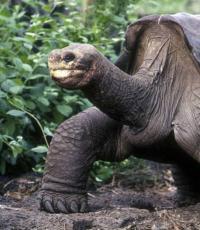The last Abingdon elephant tortoise has died. The last Abingdon elephant tortoise died Who was a resident of the Galapagos Islands lonely George
In the early morning of Sunday, June 24, perhaps the most famous tortoise in the world, a Galapagos named Lonely George, died. Together with George, a whole subspecies of giant reptiles disappeared from the planet, which once inhabited the Galapagos Islands in abundance, but were exterminated by people in just a hundred years.
background
The first of the many islands of the Galapagos archipelago was formed about 5-10 million years ago. Its "parent" was a volcano: the material that makes up the island is hardened lava. Following the first island, a second, third, and so on formed - now the group includes 16 large islands and many small formations. The archipelago is located in the region of the Galapagos Rift - a transverse fault in the earth's crust, which manifests itself as constant ejections of lava. This volcanically active zone is called the Nazca plateau, and it is slowly shifting to the southeast at a rate of about seven centimeters per year. Accordingly, older islands move away over time, giving way to younger ones.
Moving away from the place of their formation, the islands are slowly covered with vegetation, although rather sparse compared to the mainland regions located at the same latitude - that is, almost at the equator. But the relative poverty of the plant world is more than compensated by its uniqueness. There are practically no sources of fresh water on the islands, and the climate there is very cool, so the plants that ventured to gain a foothold in the Galapagos had to develop a fair amount of adaptations to harsh conditions.
Island animals also differ markedly from their relatives on the "mainland" - the vast majority of species living in the Galapagos are endemic, that is, unique to this particular place. By staying on the islands, the tetrapods and birds got a dreary landscape, harsh climate, and often a very poor choice of food, but saved themselves from the mainland's countless predators.
Story
George's ancestors appeared on one of the smallest islands of the Pinta archipelago a very long time ago. The giant tortoises - the length of the dorsal shield of their shell reaches one meter or more - had no natural enemies in the Galapagos, so they bred for their own pleasure and freely roamed the island, eating juicy grass. There were so many leisurely reptiles covered with thick bone plates that the islands were even named after them - the Spanish word "galapago" means one of the varieties of aquatic turtles.
While we were at the top of the island, we ate exclusively turtle meat. The fried breast part of the shell with the meat left on it is very good, and the cubs make an excellent soup. But in general, turtle meat, for my taste, is nothing special.
The island idyll remained unchanged for thousands of years, until one day, which was no different from the others, people appeared on the island. They quickly realized that turtles were not able to defend themselves against enemies, and since there was no other food for Pinta, they quickly mastered the preparation of various dishes from turtle meat. Sailors hunted not only for adult turtles, but also for cubs, from which a very tender soup was obtained.
A little later, people decided to colonize the Galapagos and, in order to make life on the uncomfortable islands more enjoyable, they brought their pets with them. This turned out to be a fatal decision: if the pigs simply trampled the grass, then the goats ate it at such a speed that entire turtle families died of starvation. There were also dogs that did not dare to attack turtles, but they took great pleasure in catching unsuspecting iguanas. Gradually, giant tortoises on the island of Pinta met less and less until they disappeared altogether.
A few more decades passed, and when it seemed that the island had finally died, the situation suddenly changed for the better. Similar processes took place on the neighboring islands of Pinto, and although the consequences there were not so catastrophic due to their larger size, it became clear to environmentalists that the Galapagos Islands needed to be saved, and urgently. In order to prevent the transformation of a unique nature reserve into a lifeless desert, in 1974 a large-scale program was launched on the archipelago to restore the turtle population. Scientists have also tried to save other endemic animals.
To stop the destruction of the islands, it was necessary, first of all, to get rid of goats and other introduced species. In 1959, the fishermen brought with them only three herbivores: a male and two females. By 1973, more than 30 thousand individuals lived on the island. The extermination of the goats that have bred on the archipelago required a lot of efforts from environmentalists: they finally managed to cope with this task only in 2009. More than 80,000 animals and over six million dollars were spent during the impact phase.
In parallel, the researchers, as best they could, restored the number of turtles on the islands. As a result of their efforts, the number of giant reptiles has increased from 3,000 in 1974 to 20,000 today.
The present
But for the subspecies Chelonoidis nigra abingdoni, to which Lonely George belonged, the story, alas, was over forever. By the time the Galapagos Islands restoration program began, it was believed that C. n. abingdoni extinct, but in 1972 (according to other sources, in 1971), the Hungarian biologist Josef Vazvolgyi noticed a characteristic silhouette on Pinta Island. The miraculously preserved turtle was placed in a specially equipped enclosure and began to search for suitable partners for George.
Since other known representatives of the subspecies C. n. abingdoni left, scientists selected girlfriends for George from the closest groups. As a result, we settled on two females caught on the neighboring island of Isabella. For the first 15 years of living together, George did not show any interest in the ladies, but in 2008 one of the turtles laid eggs. Scientists immediately placed them in an incubator, but, despite all the thoroughness of nursing, not a single cub hatched. A year later, one of George's companions laid eggs again, and again to no avail.
The lonely male did not try to leave offspring anymore - perhaps the difference between the two subspecies, which was insignificant for people, seemed too big for him. In 2011, two females from the island of Hispaniola, belonging to the subspecies C. n. hoodensis- a closer analysis showed that genetically they are closer to George than the turtles from Isabella. New girlfriends remained with the rescued until his death, but George did not want to mate with any of them.
The corpse of the last representative of the once numerous subspecies C. n. abingdoni discovered in the early morning of June 24 by the keeper of the enclosure, who had been caring for the turtle for more than 40 years. Judging by the posture, George was heading for a water hole. The exact cause of the death of the animal is still unknown - in the near future, experts intend to conduct an autopsy and understand what happened to him. By the standards of giant tortoises, which are believed to live for two hundred years, George was still very young - he was hardly over a hundred.
Future
Despite all the tragedy of what happened, some researchers believe that the subspecies C. n. abingdoni can still be restored. According to some reports, the giant tortoise living in the Prague Zoo is the same species as George. Later, DNA analysis disproved these assumptions, but in 2007, scientists found animals on Isabella Island whose genes contained about half of George's genes. In other words, the found turtles were most likely born from a union C. n. abingdoni with a representative of some other subspecies. And it cannot be ruled out that the parent of unusual animals has not yet died, which means that it is possible to find him.
A tortoise named Lonely George, thought to be the last of the Abingdon elephant tortoise subspecies, died of natural causes at the end of June in a wildlife sanctuary on Santa Cruz Island in the Galápagos archipelago.
However, recently, as reported in the British press, scientists have found relatives of George. Thus, the death of George does not mean the extinction of the subspecies.
There are at least 17 tortoises in the Galapagos Islands that share genetic traits similar to George, including those of the same genus, according to a statement from the Galapagos National Park. So George's death doesn't mean the end of the giant tortoise species. Chelonoidis abingdonii.

Such a conclusion was made by scientists at Yale University, who found nine females, three males and five cubs with the genes of a giant tortoise from Pinta Island, where Lonely George was found in 1972.
"Researchers compared more than 1,600 DNA samples taken in 2008 from turtles living at the Wolf volcano on Isabela Island with George's genes and samples stored at the Pinta Island Turtle Museum. The results showed that among the turtles at the volcano there may be hybrids , and individual individuals on Pint may be purebred," the newspaper notes.
Scientists have found Lonesome George in December 1972 on Pinta Island. He received his name in honor of the American actor George Gobel. Later, the turtle was transported to another island in the archipelago. George was kept in captivity at the Charles Darwin Research Station in the Galapagos Islands.

For decades, scientists have been trying to get offspring from the union of Lonesome George and Galapagos tortoises of other subspecies, but this has not worked out. Once, a female Galapagos tortoise, after mating with George, laid eggs, but the cubs never hatched.
Giant Galapagos tortoises can weigh up to four hundred kilograms and reach 1.8 meters in length. Elephant tortoises were extirpated from the Galapagos Islands about 150 years ago. According to documentary sources, whalers took several million individuals from the islands during the 18th-19th centuries as provisions.
Sailors called the turtles "living canned food" because they could live for a long time in the hold of a ship without food or water. Currently, 30-40 thousand turtles of ten different species live on the islands, while a few centuries ago their number was ten times higher.
The Galapagos Islands are located in the Pacific Ocean and belong to the state of Ecuador. The Galapagos Islands area is home to many unique species, including giant tortoises, iguanas, some bird species and other animals.
According to scientists, observations of the Galapagos tortoises became the starting point for Charles Darwin in creating the theory of evolution through natural selection. While traveling through these islands, the scientist noticed that the shells of turtles from different islands have differences in shape.
According to ria.ru
The last representative of the subspecies of the Abingdon elephant tortoise known to mankind (lat. Geochelone nigra ssp. abingdoni), a male named Lonely George, died on June 24 in the Galapagos National Park.
Lonesome George (Spanish Solitario Jorge; English Lonesome George) is a male Galapagos tortoise, considered the last and only representative of the subspecies Abingdon elephant tortoise (lat. Geochelone nigra ssp. abingdoni). Elephant tortoises are the rarest species of giant pinto tortoises, found exclusively in the Galapagos Islands. George has become a symbol of conservation in the Galapagos Islands.
George was found by a Hungarian scientist on the island of Pinta (a small island in the north of the archipelago, also called Abingdon) in 1972. Named after American actor George Gobel. Theoretically, turtles of this species are able to maintain the ability to reproduce even at the age of 200 years. After George's death, the Abingdon elephant tortoise subspecies is considered extinct.

For decades, zoologists have tried to get offspring from George, but to no avail. At one time, scientists believed that George was not capable of reproduction at all, but this turned out not to be the case. In May 2007, after a genetic analysis of 2,000 turtles, a female from Wolf volcano was discovered, genetically similar to George, being a hybrid and having a paternal relative of George, after which there was hope for continuation of the family. Fertilization occurred, but the embryos in the eggs were not viable.

George was often called the most famous bachelor in the world.
Lonesome George is dedicated to the non-fiction book Lonesome George: The Life and Loves of the World's Most Famous Tortoise by Henry Nichols.

On June 24, 2012, the body of a unique reptile was found without signs of life by the caretaker of the reserve Fausto Llereno, who had been caring for the turtle for 40 years. Lonely George died at the age of about 100 years without giving offspring. This means the extinction of the corresponding subspecies. Once opened, the tortoise will be embalmed and exhibited in a local museum so that future generations will have a visual representation of the extinct reptile.
Developments
Employees Galapagos National Park Ecuador reported that Lonely George , a giant tortoise that scientists believe is the last of its kind, has died at the age of about 100 years.
Official representatives of the park said that after the autopsy, the cause of death of this animal will become clear. Lonely George was known as a unique and one of a kind creature, as he left no offspring. For several decades, scientists have unsuccessfully tried to cross Lone George with representatives of close subspecies of the Galapagos tortoises.
The turtle was found dead by a park attendant. Fausto Llerena who has cared for animals for the past 40 years.
Although the exact age of Lonesome George was not known, scientists suggest that he was about a hundred, and he was considered a fairly young representative of his species, as these turtles lived to be 200 years old.
Lonely George was found by a Hungarian explorer on the Galapagos island Pinta in 1972. Conservationists say that the species Chelonoidis nigra abingdoni to which it belonged would now be considered extinct.
Lonely George was a participant in the animal breeding program of the Galapagos National Park. For 15 years of living next to a female turtle, which was brought from the area of the Wolf volcano, Lonesome George mated with her more than once, but her eggs always turned out to be infertile.
He was also left in paddocks with the females of Hispaniola Island, who were genetically closer to him than the Wolf Volcano female, but George refused to mate with them at all.
Lonesome George has become a symbol of the Galapagos Islands and attracts around 180,000 tourists each year. His body will be embalmed and preserved in a museum for future generations.

There were quite a lot of these turtles on the Galapagos Islands until the end of the 19th century, but later they were mercilessly exterminated by sailors for their meat, which led to the extinction of the species. Turtles also suffered from habitat loss after invasive animals such as goats were brought here from the mainland.
The difference in appearance between turtles from different Galapagos Islands helped the British Charles Darwin, who came to the islands, to formulate his famous theory of evolution. Today, about 200 thousand turtles of various species live on the Galapagos Islands.
shells beak-chested turtles conservationists deliberately deface them by branding them harmless to animals. By doing this, they make beautiful shells completely worthless on the black market. Only a couple of hundred of these animals remain in the wild, they are in serious danger of extinction.
-- Giant elephant tortoises you have to mate in a special way so that the male, whose weight can reach 400 kilograms, does not crush the female.
Poachers, sometimes called the "turtle mafia", as well as locals who love turtle meat, threaten the rare Madagascar tortoises, among which beak-breasted, spidery, radiant and flat-tailed turtle.
-- radiant turtles are one of the most beautiful species of turtles on the planet. They live only in the forested areas of the southern part of the island of Madagascar.
-- Burmese tortoise also on the verge of extinction. Sometimes it is called the "star turtle" due to the unusual coloring of the shell.
-- Egyptian tortoise - the smallest of all types of turtles in the Mediterranean.
Kingdom: Animals (Animalia).
Type: Chordata.
Class: Reptiles (Reptilia).
Order: Turtles (Testudines).
Family: Turtles (Testudinidae).
Genus: American tortoises (Chelonoidis).
Species: Elephant turtle (Chelonoidis nigra).
Subspecies: Abingdon elephant turtle (Chelonoidis nigra abingdoni).
WHY IS INCLUDED IN THE RED BOOK
The Abingdon Elephant Tortoise is one of the clearest examples of the fact that the Red Book is a "living" book. It changes every day and perhaps every hour. Scientists do not always have time to quickly track what is happening and find a sufficient number of convincing facts. It is clear that by the time this edition is published, the Abingdon elephant tortoise will be classified as EX, marked in black, as an extinct species. As we have already said, when work began on the description of this subspecies, the last representative of the rare taxon was still alive. His name was Lonesome George.
Lonely George was discovered on Pinta Island (Abingdon) on December 1, 1972 and taken under observation. The last years of his life, he lived in the Galapagos National Park of Ecuador, at the station. Charles Darwin on Santa Cruz Island. Here, George was well looked after and hoped to get viable offspring from him. Several unsuccessful attempts have been made to cross George with females of other subspecies. Although the eggs were laid, none of them hatched. Scientists believe that at the time of death, George was 90-100 years old. Since these reptiles were long-lived in the animal kingdom and retained the ability to reproduce almost until the end of their lives, there was still hope for a successful restoration of the subspecies during George's lifetime. Researchers will have to carefully test the genetic structure of populations of other related taxa living in the Galapagos Islands. Real proof is needed that George was in fact "the last of his kind".
In the 19th century Abingdon elephant tortoises abounded on Pinta Island. The main reason for the disappearance of the subspecies was that almost all vegetation on the island was exterminated by feral goats. As a result, the turtles had no food resources left. Clumsy and slow reptiles were easy prey for poachers.
By the beginning of the 1970s. 20th century only one representative of the subspecies managed to survive. Scientists until the last hoped to restore the subspecies and return it to its natural habitat. In addition, numerous attempts to regulate the number of goats on the island of Pinta were eventually successful, and the herbaceous cover of the island was finally restored. Lonely George has been a symbol of the Galapagos Islands and of the endangered species conservation movement in general. Various celebrities came to visit Lonely George, including Prince Charles and Hollywood actress Angelina Jolie.
WHERE Dwells
The Abingdon elephant tortoise is an endemic subspecies that lived exclusively on the uninhabited island of Pinta in the Galapagos archipelago.
HOW TO FIND OUT
Abingdon elephant tortoises 100% justified the species name given to them - "elephant". These were real giants, sometimes reaching a body weight of 300-350 kg. Their large, ossified carapace was dyed a deep grey-brown. In all turtles, including elephants, the ribs and spine are inseparably fused with the carapace. Such a system forms a powerful defense for the body. Therefore, the myth that the turtle can leave its "house" has no scientific evidence. The body of turtles was covered with dryish wrinkled skin. Elephant tortoises had a long neck and a relatively small head. Males were almost twice as large as females.
LIFESTYLE AND BIOLOGY
Being cold-blooded animals, turtles crawled out in the morning to bask in the sun. The dark color of the shell helped absorb more sunlight and better warm up the body. Then the turtles spent most of their time looking for food. Moving at an average speed of 0.3 km / h, they systematically examined the territory of their native island, hoping to find fresh, juicy grass to support vitality. Elephant turtles were distinguished by almost undeveloped hearing, but excellent sense of smell and good eyesight.
During the mating season, the males staged ritual fights, trying to determine the most important and strong. They stretched their necks, opened their mouths, stood in ritual poses. At this time, as well as at the time of mating, the males could puff and hiss, trying in every possible way to express the emotions that overwhelmed them. For oviposition, females went to dry, well-warmed sandy beaches. Sometimes it took them several days to dig a hole about 30 cm deep. Using their hind legs, the female Abingdon elephant tortoise patiently performed complex and serious work. The sex of the embryos in these reptiles depends on the temperature of the environment. At lower temperatures, more males are born; at higher temperatures, more females. Incubation could last from four to eight months. After birth, babies faced many dangers. First of all, they needed to get to the surface and not become a victim of birds of prey. Sexual maturity occurs at the age of about 20-25 years.
Elephant tortoises have made a huge contribution to the development of the general theory of evolution. After all, it was them, or rather the external differences of individuals living in different environmental conditions, that Charles Darwin noticed during a round-the-world trip on the Beagle. The fact is that the size and shape of the shell in representatives of different populations of elephant turtles are very different. This made the great scientist seriously think about the influence of the environment on the body.
5 041



